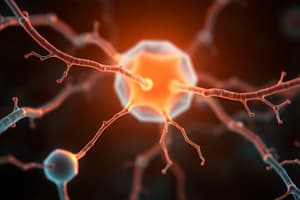Podcast
Questions and Answers
What are sensory receptors?
What are sensory receptors?
Respond to changes in environment (stimuli)
Which of these are classified types of stimuli? (Select all that apply)
Which of these are classified types of stimuli? (Select all that apply)
- Thermoreceptors (correct)
- Mechanoreceptors (correct)
- Photoreceptors (correct)
- Chemical receptors
- Nociceptors (correct)
What do mechanoreceptors respond to?
What do mechanoreceptors respond to?
Touch, pressure, vibration, and stretch
What do thermoreceptors respond to?
What do thermoreceptors respond to?
What do photoreceptors respond to?
What do photoreceptors respond to?
What do chemoreceptors respond to?
What do chemoreceptors respond to?
What do nociceptors respond to?
What do nociceptors respond to?
In terms of classification by location, which of these are types of receptors? (Select all that apply)
In terms of classification by location, which of these are types of receptors? (Select all that apply)
What receptors respond to stimuli outside the body?
What receptors respond to stimuli outside the body?
What receptors respond to internal stimuli?
What receptors respond to internal stimuli?
What receptors advise the brain of body movements?
What receptors advise the brain of body movements?
What are non-encapsulated nerve endings?
What are non-encapsulated nerve endings?
Where are itch receptors located?
Where are itch receptors located?
What is the function of the joint kinesthetic receptors?
What is the function of the joint kinesthetic receptors?
What is the role of the somatosensory system?
What is the role of the somatosensory system?
What is transduction in the context of sensory receptors?
What is transduction in the context of sensory receptors?
What types of receptors provide a sustained response with little to no adaptation?
What types of receptors provide a sustained response with little to no adaptation?
Which type of reflex is rapid and predictable? (Select one)
Which type of reflex is rapid and predictable? (Select one)
What is the purpose of the knee-jerk reflex?
What is the purpose of the knee-jerk reflex?
Flashcards are hidden until you start studying
Study Notes
Sensory Receptors
- Sensory receptors detect changes in the environment, or stimuli.
- Types include mechanoreceptors, thermoreceptors, chemoreceptors, nociceptors, and photoreceptors.
Mechanoreceptors
- Respond to touch, pressure, vibration, and stretch.
- Key for sensing blood pressure and body movement.
Thermoreceptors
- Detect changes in temperature.
Photoreceptors
- Located in the retina of the eye, they respond to light.
Chemoreceptors
- Respond to chemical stimuli, including taste and smell.
Nociceptors
- Specialized for detecting pain.
Receptor Classification by Location
- Exteroceptors: Respond to external stimuli.
- Interoceptors: Respond to internal body stimuli.
- Proprioceptors: Detect internal stimuli related to body movements, located in tendons, muscles, and joints.
Nerve Endings
- Non-encapsulated nerve endings: Found in epithelia and connective tissue; free nerve endings are abundant.
- Encapsulated nerve endings consist of sensory neuron terminals enclosed in connective tissue (e.g., tactile corpuscles, lamellar corpuscles).
Tactile Structures
- Tactile (Merkel) discs: Located in the deepest layer of the epidermis; sensitive to light touch.
- Hair follicle receptors: Detect movement of hair.
Proprioceptor Types
- Muscle spindles monitor muscle stretch.
- Tendon organs located in tendons signifying muscle tension.
- Joint kinesthetic receptors monitor stretch in joint capsules.
Somatosensory System Functions
- Serves the body wall and limbs, integrating inputs from various receptors.
Processing Sensations
- Receptor processing involves specifying the type of stimulus, receptive fields, transduction, and sensing thresholds.
- Transduction converts stimulus energy into graded potential.
Receptor Types
- Phasic receptors: Adapt quickly; report changes in stimuli (e.g., lamellar, tactile corpuscles).
- Tonic receptors: Sustain response without significant adaptation (e.g., nociceptors).
Perception of Stimuli
- Identifying sensations involves processing at various levels (circuit and perceptual).
- Magnitude and spatial discrimination help ascertain stimulus intensity and location.
Reflexes
- Inborn reflexes: Automatic responses to stimuli (e.g., pulling away from hot water).
- Learned reflexes: Developed through experience (e.g., driving).
- Spinal reflexes function without brain involvement; spinal shock depresses responses after injury.
Muscle Spindles and Tendon Organs
- Muscle spindles: Detect length changes in muscles.
- Tendon organs: Assess tension on muscles and tendons.
Efferent and Afferent Pathways
- Somatic efferent nerves conduct impulses to skeletal muscles.
- Visceral afferent nerves relay signals from smooth muscles and glands.
- Ganglia are clusters of neuron cell bodies associated with nerves.
Peripheral Nerve Structures
- Mixed nerves have both sensory and motor fibers.
- Cutaneous nerves primarily supply the skin.
- Plexuses are complex networks of ventral rami branching near the vertebral column.
Specific Nerve Structures
- Phrenic nerve: Receives fibers from C3-C5 for diaphragm control.
- Brachial plexus: Supplies the upper limb with major branches like the axillary, musculocutaneous, and median nerves.
Reflex Classification
- Mono synaptic reflex: Involves one sensory and one motor neuron, is ipsilateral (same side).
- Withdrawal reflex: Initiated by painful stimuli leading to immediate withdrawal actions.
Central Nervous System Pathways
- Upper motor neurons from the motor cortex initiate movements.
- Pre-command areas regulate outputs from motor centers and maintain higher motor control.
Neurotransmission
- Acetylcholinesterase breaks down acetylcholine at neuromuscular junctions.
System Coordination
- Internal feedback loops convey information to lower motor neurons, facilitating refined motor activity.
Studying That Suits You
Use AI to generate personalized quizzes and flashcards to suit your learning preferences.




